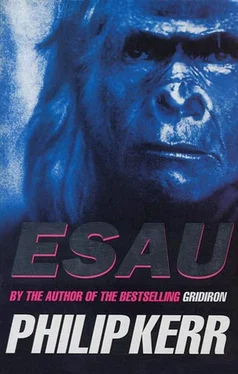‘Aren’t you coming?’ said Swift.
‘We can’t all go. Besides, there are plenty of things that need to be done here.’
The sirdar nodded.
‘Jack is right, memsahib. Make better hunter to be small party.’
Jameson straightened and spoke to the sirdar in Nepali.
‘Huncha. Kahile jaane?’
‘Turantai, Jameson sahib. Right away.’
‘Good,’ said the Zimbabwean, and smiled at Swift. ‘Right then. I’d better go and get my gear together.’
Everyone began to trudge back to the campsite, Jameson, Swift, and Hurké outpacing the others in their eagerness to get started, leaving Mac behind to take yet more pictures. Jack walked slowly abreast with Warner, Boyd, and Cody.
‘You mentioned some things that needed to be done,’ said Boyd. ‘Anything I can help with?’
‘Well,’ said Jack, ‘if that chicken wire arrives today, I thought I’d start on the avalanche barriers. Thanks for the offer, but the Sherpas will help. You might as well get started on finding your core samples.’
‘Thanks, I think I will.’
‘It was an avalanche up there that wiped out you and your buddy, wasn’t it. Jack?’ said Warner. ‘There was something in National Geographic about it.’
‘That’s right.’
‘Must have been terrifying for you. I can’t imagine what it would be like, to be caught up there in an avalanche. Not that I would be.’ The black American shook his head warily. In his brightly coloured wraparound sunglasses and expensively furred parka, he looked like some kind of rap artist. ‘I like my big feet on flat ground.’
‘It’s hard to be sure, but I always reckoned that the actual avalanche was caused by a meteorite.’
‘A meteorite, eh?’ said Boyd. ‘Interesting.’
‘I’ve always wondered if that’s how life got started on this planet,’ said Warner. ‘A few molecules on a piece of intergalactic rock? Did you know that the earliest reports of meteoritic phenomena are recorded on Egyptian papyrus, around 2000 B.C.?’
Warner turned toward Boyd.
‘No offence intended,’ he said.
‘None taken,’ said Boyd. ‘Actually, I’ve always been interested in meteorites myself.’
‘If it was a meteorite, you were lucky, Jack,’ said Warner. ‘The one at the Hayden Planetarium in New York weighs thirty tons. Any idea where yours might have come down?’
‘Are you thinking of looking for a souvenir?’ laughed Boyd. ‘Thirty tons of rock is a lot of excess baggage to take back to the States.’
‘I was just curious.’
‘Hard to be sure,’ admitted Jack. ‘But I had the idea that it came down behind us, somewhere on the glacier to the south of us.’ He pointed in front of them, along the line of strange new tracks, beyond ABC, toward the entrance to the Sanctuary itself. ‘That way. Toward Machhapuchhare.’
‘Fish Tail Peak, eh?’ mused Cody. ‘Yes, it does kind of look like one, doesn’t it? What is that? About six or six and the half thousand?’
‘Six thousand nine hundred and ninety-two,’ said Jack.
‘One hell of a walk, anyway,’ Boyd guffawed.
‘Technically speaking, it’s not a particularly difficult climb.’
‘They really believe that it’s a holy mountain?’ said Warner. ‘The sacred home of the gods and all that jazz?’
‘They do believe it,’ affirmed Jack.
‘That kind of stuff hardly seems possible in this day and age.’
‘The longer you stay here,’ said Jack, ‘the more it will seem possible.’
The use of drugs for the restraint and immobilization of wild animals was routine for Miles Jameson. During his time at the Los Angeles Zoo, Jameson had drugged everything from an Indian elephant to an axolotl. He had used many of the chemical agents in his arsenal for two decades, almost as long as they had been around. But his preferred system for delivering a chemical restraint — a blowpipe — had been around for much longer. Working in the zoo, Jameson most often used a blowpipe that had been presented to him by some Ecuadorian Indians on one of his many specimen-hunting trips to Central America: a two-metre length of hollowed bamboo, the blowpipe had an effective range of fifteen to twenty metres, offering silent projection-anaesthesia with minimum trauma upon impact. Jameson had brought the blowpipe with him to the Chitwan National Park, but faced with the task of immobilizing an animal in the high winds of the Himalayas and over large distances, Jameson thought he would have little choice but to use a rifle.
As well as a selection of modified air pistols for the general use of members of the expedition, he had brought two pairs of Palmer Cap-Chur projector guns up from Chitwan. The first pair were two long-range rifles powered by compressed carbon dioxide, with a range of thirty-five yards. But it was to the second pair of guns that Jameson was trusting the most: these were two extra-long-range Zuluarms rifles, each utilizing a modified over-and-under combination of .22-calibre rifle and twenty-eight-gauge shotgun, powered by percussion caps and accurate up to seventy-five metres. The Zuluarms rifle fired a special Cap-Chur aluminium-bodied syringe similar to the kind Jameson used in his Ecuadorian blowpipe.
The choice of chemical restraint was more problematic. Liquid injected with excessive pressure could tear muscle. Worse, it was often fifteen or twenty minutes before complete immobilization was effected — perhaps longer in the freezing conditions of the Himalayas — by which time an animal could be lost and, unassisted, might even die from respiratory depression. Most complicated of all was the calculation of a safe but effective dose for an animal that Jameson had neither seen nor knew anything about.
With great apes in the L.A. Zoo, he had always favoured the use of Ketamine Hydrochloride. The one side effect of Ketamine was the hallucinations it induced, of which Jameson had personal experience, having once accidentally injected himself with a dose intended for a chimpanzee.
Ketamine dosage in great apes was 2–3 milligrams per kilogram of body weight. Miles had little alternative but to guess the weight of the creature as in the neighbourhood of two hundred to hundred and and twenty-five kilos based on the descriptions given by Jack and the sirdar of a yeti as being about a third larger than a big silverback gorilla. But following the sirdar’s examination of the tracks and his pronounced opinion that this was a smaller yeti they were tracking, he had also prepared a Cap-Chur syringe containing a much weaker dose.
Before leaving ABC, Jameson checked the massive squeeze cage he and some Sherpas had assembled the previous day. If they were lucky enough to capture a live specimen this was where it would be kept. Transporting it there, on a stretcher, would be rather less simple, and he thought that, weather permitting, they might just have to call in the helicopter.
Jameson selected the Zuluarms, inserted a percussion cap into the rifle barrel, and a weaker-strength Cap-Chur syringe into the shotgun barrel. Then he slipped the safety catch on, pocketed a couple of spare syringes, which were plugged at the tip, collected his binoculars, slung the rifle over his shoulder, and went up the ladder of the lodge to find Swift and the sirdar.
‘The great tragedy of Science — the slaying of a beautiful hypothesis by an ugly fact.’
T. H. Huxley
The yeti, or whatever animal it was, had headed straight down the valley toward the site of what in summer was MBC — Machhapuchhare Base Camp — where, at the foot of Shiva’s special mountain, two or three lodges were also buried under several metres of snow. Four hundred and twenty-five metres lower down than ABC, it was a trek of about one and a half hours. The tracks were easy to follow and seemed almost human in their apparent single-mindedness, observing an almost straight line until, after over an hour of walking, the sirdar pointed to some marks in the snow where the creature had apparently sat down on a rock.
Читать дальше












